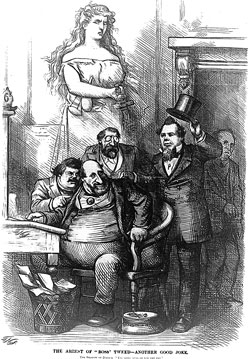Dec. 4, 1875: Boss Tweed escapes

Photo courtesy of Library of Congress/Thomas Nast/Harper’s Weekly.
Tammany Hall, so named for its 14th Street meeting place, was from 1858 the domain of William Magear “Boss” Tweed, the famously corrupt head of New York City’s Democratic Party machine. Tweed rose during one term in the U.S. Congress to become infinitely more powerful as grand sachem of the Tammany Society with virtually unlimited control over political patronage at every level in the state.
Tweed and his associates leveraged their political power to siphon hundreds of millions of dollars from land speculation, public works projects and outright bribes. At the height of his power, Tweed and his confederates could influence nearly every significant position in government—from ward-level bosses to the highest courts. Tweed derived that power, however, from his grasp and control of Irish immigrants who, by their sheer numbers, helped him manipulate elections. But in 1871, a clash between Irish Protestants and Catholics resulted in the deaths of more than 60 civilians, testing the city’s tolerance of the Tammany machine.
Invigorated reformers, led by Democrat Samuel Tilden, launched a series of investigations. Tweed was arrested, but still re-elected to office. When he was finally brought to trial, he bragged that he would never be convicted. In his first trial, the jury—widely believed to have been bribed—failed to reach a verdict. But his second trial in November 1873 was better controlled by prosecutors and resulted in his conviction on 204 of 220 counts.
Tweed’s 12-year sentence was reduced on appeal to one year. But on release he was sued by the state for $6 million and, unable to post bail, was confined to a debtor’s prison. It proved a mere inconvenience. While confined, Tweed was allowed to leave each afternoon for a walk in Central Park or a carriage ride to his mansion. And on Dec. 4, 1875, while on such an outing, Boss Tweed disappeared.
Tweed escaped to Cuba, where he was briefly imprisoned and, unwittingly, released. From there he fled to Spain, where he was recognized by an official familiar with cartoonist Thomas Nast’s acrid portraits of Tweed in Harper’s Weekly. Tweed was returned to New York, where he agreed to testify against fellow conspirators. He died in 1878, at age 55, still imprisoned in the Ludlow Street Jail.



